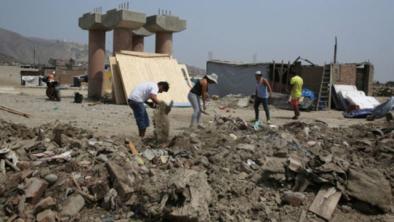Peru floods kill 67 and spark criticism of country's climate change preparedness

Sixty-seven people have been killed and thousands more forced to evacuate by intense rains which damaged 115,000 homes and destroyed more than 100 bridges in Peru’s worst floods in recent memory.
“We are confronting a serious climatic problem,” said Peru’s president, Pedro Pablo Kuczynski, in a broadcast to the nation on Friday afternoon. “There hasn’t been an incident of this strength along the coast of Peru since 1998.”
The disaster – which came after a period of severe drought – has been blamed on abnormally high temperatures in the Pacific Ocean, and fuelled criticism that the country is ill-prepared for the growing challenges of climate change.
Over the past three days, the downpour has burst river banks, created mudslides, collapsed bridges, closed roads and forced school suspensions in swaths of the west and north of the country.
Rains continued to lash the northern Piura region where streets remained flooded in the regional capital and homes had been washed away in poorer neighbourhoods.
...
It is not the first time this year that Peru has been affected. Two months ago, tourists in Machu Picchu were stranded by mudslides and had to be airlifted.
The prime minister, Fernando Zavala, said 176 districts had already declared emergencies.
Abraham Levy, a Peruvian meteorologist, said the weather conditions were “extremely unusual” and the storms and flooding were caused by the “atypical” warming of sea surface temperatures off Peru’s northern coast by five to six degrees to 29C.
He described the phenomenon as a “coastal El Niño”. The last time this was seen was nearly a century ago in 1925.
“We’ve had these kinds of El Niños as long as we have historical data, so it’s very difficult to link climate change or even global warming to these events,” he said.
Other scientists say a global trend of rising sea temperatures was likely to have contributed to the recent storms.
...
“We know the ‘coastal El Niño’ comes from time to time. We know we are a country that is extremely vulnerable to the effects of climate change. We should have prepared ourselves better,” said the leader of the New Peru movement, Verónika Mendoza, earlier this week.
...
A spokesman for the Peruvian ministry of environment said it was premature to attribute the floods to climate change though there are studies which suggest the El Niño phenomenon will become more frequent as a result of global warming.
Related Content






